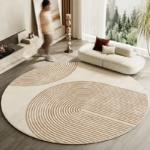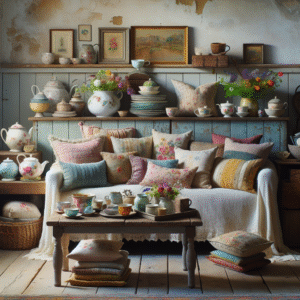Picture this: it’s Sunday evening, and your family is scattered across the house—kids on the floor by the TV, spouse reading in a corner chair that’s too far from the action, and you perched on the edge of the sofa trying to keep everyone connected. Creating a cozy family living space isn’t just about buying more furniture; it’s about understanding how strategic seating arrangements can transform your home into a warm, inviting hub where meaningful moments naturally unfold.
The magic happens when every seat serves a purpose, every arrangement encourages connection, and every family member feels they have their perfect spot. Whether you’re working with a compact apartment or a sprawling family room, the right seating strategy can make your space feel both intimate and functional.
In this comprehensive guide, we’ll explore how to create seating magic that brings your family together. You’ll discover practical furniture arrangement techniques, learn about space-maximizing solutions, and uncover design principles that make any living space feel perfectly tailored to your family’s lifestyle. From choosing the right pieces to arranging them for maximum coziness, we’ll cover everything you need to transform your living area into the heart of your home.
Understanding Your Family’s Seating Personality
Before diving into furniture selection, successful living space design starts with understanding how your family actually lives. Every household has unique patterns—what designers call “seating personality”—that determine which arrangements will work best.
Observe your family for a week. Who prefers to sprawl while watching movies? Which family member always claims the same spot? Does your teenager like to do homework while staying connected to family activities? These insights become the foundation for creating effective seating arrangements.
Identifying Natural Gathering Patterns
Most families have predictable gathering patterns that reveal themselves during different activities. Morning coffee might draw everyone to the kitchen island, while evening conversations happen naturally around the main seating area. Understanding these patterns helps you position furniture to support, rather than fight against, your family’s natural rhythms.
Consider the “conversation zone”—that magical distance where family members can easily chat without raising voices. Research from interior design studies shows this sweet spot measures between 4 to 8 feet, depending on the activity and noise level in your home.
Accommodating Different Comfort Preferences
Every family member has distinct comfort preferences that impact seating choices. Some prefer firm support for reading, while others want deep cushions for relaxation. Teenagers often favor floor seating options, while grandparents need supportive chairs with good back support.
Creating a successful family living space means providing variety within a cohesive design. Think of your seating arrangement as a collection of micro-environments, each serving different needs while contributing to the overall harmony of the space.
Essential Seating Pieces for Family Harmony
Building the perfect family seating arrangement requires understanding which furniture pieces deliver the most value for your space and lifestyle. Rather than filling a room with random pieces, strategic selection creates both function and visual appeal.
The Anchor Piece: Choosing Your Main Seating
Your main seating piece—typically a sofa or sectional—serves as the room’s anchor and sets the tone for everything else. For family living spaces, prioritize comfort and durability over trendy styles that might not stand up to daily use.
Sectional sofas work exceptionally well for families because they naturally create intimate conversation areas while accommodating multiple people. L-shaped configurations are particularly effective in open floor plans, helping to define the living area without walls.
When selecting your anchor piece, consider the 60-30-10 rule: your main seating should occupy roughly 60% of your available seating real estate, with secondary and accent pieces filling the remaining space.
Secondary Seating That Multitasks
Smart secondary seating pieces earn their place by serving multiple functions. Ottoman storage benches provide extra seating during gatherings while hiding toys, games, or seasonal items inside. Swivel chairs allow family members to engage with different areas of an open floor plan without constantly relocating.
Consider incorporating a reading chair with good task lighting for quiet activities, or a bench that can serve as extra seating during parties but normally provides a place to put on shoes or display plants.
Flexible Floor Solutions
Don’t overlook floor-level seating options that appeal especially to children and teenagers. Large floor cushions, poufs, and even strategically placed area rugs create casual seating that can be easily reconfigured for different activities.
Floor seating works particularly well for movie nights, game sessions, or homework time. Choose pieces with removable, washable covers and medium-firm support that won’t flatten quickly with use.
Space-Maximizing Arrangements for Every Room Size
Creating cozy family seating isn’t limited by square footage—it’s about maximizing the space you have through thoughtful arrangement and smart furniture choices.
Small Space Seating Solutions
In compact living areas, every piece must work harder. Wall-mounted or floating furniture creates visual breathing room while providing necessary function. Consider a loveseat paired with a couple of lightweight chairs that can be moved as needed, rather than a large sectional that dominates the space.
Vertical thinking transforms small spaces. High-back chairs draw the eye upward, making ceilings appear taller. Built-in bench seating along walls maximizes floor space while providing ample seating for gatherings.
The key to small space success lies in maintaining clear sight lines. Arrange furniture so you can see from one end of the space to the other, which creates an illusion of greater space even when the room is fully furnished.
Large Room Arrangement Strategies
Spacious family rooms present different challenges—primarily avoiding the “furniture floating in a sea of space” problem that makes large rooms feel cold and disconnected.
Create multiple conversation areas within a large room using furniture groupings. Position your main seating to face each other across a coffee table, then create a secondary reading nook with a comfortable chair and side table near a window or bookshelf.
Use area rugs to define separate zones within a large space. Each seating area should have its own rug that’s large enough for at least the front legs of all furniture pieces to rest on it.
Open Floor Plan Navigation
Open concept homes require seating arrangements that define spaces without blocking flow. Use your sofa back as a room divider, positioning it to separate the living area from the kitchen or dining space while maintaining visual connection.
Consider sight lines from the kitchen to main seating areas. Many families spend significant time cooking while others relax, and maintaining visual connection keeps everyone feeling included in family activities.
Creating Conversation Zones That Actually Work
The most successful family living spaces facilitate natural conversation through strategic furniture positioning and thoughtful lighting design.
The Science of Comfortable Conversation
Effective conversation zones follow specific spatial principles. Seats should be positioned at slight angles to each other rather than parallel, which feels more natural and inclusive. The ideal conversation distance ranges from 4 to 8 feet—close enough to speak normally but far enough to respect personal space.
Height variation adds visual interest while accommodating different preferences. Combine standard-height seating with slightly lower pieces like ottomans or floor cushions to create a dynamic, comfortable arrangement.
Avoid the common mistake of pushing all furniture against walls. Floating furniture in the room creates more intimate conversation areas and allows for better traffic flow around the space.
Lighting for Different Activities
Conversation zones need layered lighting that can adapt to different activities and times of day. Combine ambient lighting (overhead fixtures or recessed lights) with task lighting (reading lamps or table lamps) and accent lighting (candles or decorative fixtures) for maximum flexibility.
Position table lamps or floor lamps near seating areas to create pools of warm light that naturally draw people together. Dimmer switches allow you to adjust lighting intensity based on the activity and mood you want to create.
Kid-Friendly Seating That Grows with Your Family
Family-focused seating arrangements must balance adult comfort with child-friendly practicality, creating spaces where everyone feels welcome and comfortable.
Durable Fabric and Material Choices
When children are part of the equation, fabric selection becomes crucial for long-term satisfaction. Performance fabrics designed for high-traffic commercial use offer excellent durability for family homes. Look for fabrics with high double-rub counts (30,000 or higher) that resist staining, fading, and wear.
Leather, particularly top-grain or full-grain varieties, develops character over time while remaining easy to clean. For families preferring fabric, consider removable, washable slipcovers that can be refreshed seasonally or after spills.
Avoid light colors and delicate textures in main family seating areas. Medium tones with pattern or texture help camouflage inevitable wear and minor stains between cleanings.
Incorporating Play-Friendly Elements
Smart family seating arrangements include subtle accommodations for children’s activities. Storage ottomans keep toys accessible but contained. Low, sturdy coffee tables provide surfaces for puzzles or art projects without creating safety hazards.
Consider designating one area of your seating arrangement as more casual and kid-friendly, with floor cushions or bean bags that can handle rougher treatment. This gives children their own space while keeping the main seating areas more adult-focused.
Transitional Design Elements
Choose seating pieces and arrangements that can evolve as your family changes. Modular furniture systems allow you to reconfigure layouts as children grow and needs shift. Neutral base pieces can be updated with colorful pillows, throws, and accessories that reflect changing tastes without requiring major furniture investments.
Seasonal and Holiday Seating Flexibility
The best family seating arrangements adapt gracefully to seasonal changes and special occasions, providing flexibility for holiday gatherings and entertaining.
Expandable Seating Solutions
Plan your basic seating arrangement with expansion in mind. Choose lightweight accent chairs that can be easily moved from other rooms when needed. Benches and ottomans provide extra seating during gatherings but serve other purposes during regular daily use.
Consider foldable or stackable seating options that can be stored when not needed. Modern folding chairs have evolved far beyond basic utility designs, offering style and comfort that complement your regular furniture.
Holiday Transformation Strategies
During holiday seasons, simple changes can dramatically transform your seating area’s feel. Switching throw pillows and blankets immediately updates the space’s color palette and texture. Adding extra lighting through string lights or candles creates festive ambiance without permanent changes.
Plan furniture arrangements that can accommodate holiday decorations. Leave wall space for seasonal artwork or maintain clear surfaces for decorative displays. Consider how holiday trees or other large decorations might temporarily change traffic patterns and adjust seating positions accordingly.
Budget-Conscious Seating Magic
Creating beautiful, functional family seating doesn’t require unlimited funds. Strategic shopping, DIY solutions, and smart prioritization can deliver impressive results within modest budgets.
Investment vs. Savings Priorities
Focus your budget on pieces that will see the most use and need the highest quality. Your main sofa or sectional deserves investment in good construction and durable materials since it will anchor your space for years.
Save money on accent pieces and accessories that can be easily updated or replaced. Floor lamps, throw pillows, and decorative elements offer high visual impact at relatively low cost, allowing you to refresh your space without major expense.
Consider the cost-per-use calculation when evaluating furniture purchases. A more expensive piece that serves multiple functions and lasts longer often provides better value than cheaper alternatives that need frequent replacement.
DIY and Upcycling Opportunities
Many seating enhancements can be accomplished through simple DIY projects. Reupholstering dining chairs or adding slipcovers to existing furniture completely transforms their appearance at a fraction of replacement cost.
Storage ottomans can be created from simple wooden crates with added padding and fabric covers. Floor cushions require minimal sewing skills but provide valuable flexible seating options for family gatherings.
Shop secondhand stores and online marketplaces for solid wood furniture that can be refinished or painted to match your design vision. Quality furniture from previous decades often offers superior construction at prices significantly lower than new alternatives.
Technology Integration in Modern Family Seating
Today’s families need seating arrangements that accommodate technology use while still encouraging face-to-face interaction and connection.
Managing Screen Time and Family Time
Position seating to allow for both shared screen viewing and individual device use without completely isolating family members. Consider sight lines to main television areas while ensuring comfortable reading and conversation areas exist away from screens.
Incorporate charging solutions into seating arrangements through furniture with built-in USB ports or strategically placed power strips that don’t create visual clutter. Side tables and console tables can house charging stations while keeping cords organized and out of sight.
Acoustic Considerations
Multiple technology devices in family spaces can create competing audio environments. Upholstered furniture helps absorb sound, while strategic furniture placement can create natural sound barriers between different activity zones.
Consider how seating positions relate to speakers and audio equipment. Avoid placing conversation seating directly in speaker paths, which can make normal conversation difficult when entertainment systems are in use.
What’s the ideal distance between seating pieces for comfortable conversation?
The optimal distance for comfortable conversation ranges from 4 to 8 feet between seating pieces. This allows family members to speak in normal tones while respecting personal space. Closer positioning works well for intimate conversations, while the outer range accommodates larger groups and more active discussions.
How do I choose the right size sectional for my family room?
Measure your room and ensure the sectional leaves at least 14-18 inches of walkway space around all edges. The sectional should not exceed two-thirds of your room’s length or width. Consider your family size and entertaining needs—a good rule is to provide comfortable seating for your household plus 2-3 additional guests.
What are the most durable fabric options for family seating?
Performance fabrics with double-rub counts of 30,000 or higher offer excellent durability for family use. Top-grain leather, microfiber, and tightly woven synthetic blends resist stains and wear. Avoid delicate fabrics like silk, linen, or loosely woven materials in high-traffic family areas.
How can I create more seating without buying additional furniture?
Use multi-functional pieces like storage ottomans, benches, and large floor cushions. Rearrange existing furniture to create better conversation zones. Add a dining chair to reading nooks temporarily, or use outdoor furniture indoors during entertaining. Window seats and built-in benches maximize space efficiency.
Should all living room seating face the television?
Not necessarily. Create a balanced arrangement where some seating faces the TV for entertainment viewing, while other pieces encourage conversation and reading. Consider swivel chairs or modular pieces that can be repositioned based on the activity. This approach supports both family interaction and entertainment needs.
How do I arrange seating in an open floor plan?
Use your sofa back as a natural room divider to define the living space. Create multiple conversation zones with area rugs anchoring each grouping. Maintain visual connection between spaces while ensuring furniture doesn’t block traffic flow. Position seating to face each other rather than all facing outward.
What’s the best way to incorporate kid-friendly seating that doesn’t look childish?
Choose durable, cleanable fabrics in sophisticated colors and patterns that hide wear. Include floor cushions, storage ottomans, and sturdy coffee tables that accommodate children’s activities. Designate one casual zone within your arrangement specifically for child use while maintaining adult-focused main seating areas.
How often should I rearrange my living room seating?
Seasonally rearranging seating keeps your space feeling fresh and can improve function. Consider major rearrangements twice yearly, with minor adjustments monthly. Move pieces to accommodate seasonal decorations, changing light patterns, or evolving family needs. Regular rearrangement also helps identify wear patterns and maintenance needs.
Bringing It All Together: Your Seating Magic Action Plan
Creating seating magic in your family living space combines understanding your family’s unique needs with strategic design principles that maximize both comfort and connection. The transformation doesn’t happen overnight, but with thoughtful planning and gradual implementation, you can create a space that truly serves your family’s lifestyle.
Start by observing how your family currently uses your living space, then implement changes gradually. Focus first on arrangement and lighting adjustments that require no new purchases. These simple modifications often yield surprising improvements in how the space feels and functions.
Remember that the perfect seating arrangement evolves with your family. What works for young children may need adjustment as they become teenagers. Seasonal changes, new hobbies, and changing work patterns all influence how your family uses shared spaces.
The magic happens when every family member feels they have a special place in your living space—whether it’s dad’s reading chair, the kids’ floor cushion area, or mom’s spot on the sectional where she can supervise homework while folding laundry. These personal territories within shared space create the foundation for countless family memories and meaningful interactions.
Your family living space should reflect your unique personality while providing the comfort and function your daily life demands. With the strategies and insights shared in this guide, you’re ready to transform your seating arrangement into something truly magical—a space that draws your family together and makes your house feel like the warm, welcoming home you’ve always envisioned.
—
####
Content Disclaimer
The information provided in this article is for educational and inspirational purposes only. Interior design preferences and furniture needs vary significantly based on individual circumstances, family size, budget constraints, and personal style preferences. While we strive to offer practical and well-researched advice, results may vary based on your specific situation. Always measure your space carefully before purchasing furniture, and consider consulting with interior design professionals for complex room layouts or significant investments. Product recommendations are based on general quality and functionality assessments and do not constitute endorsements of specific brands or retailers.
Categories
- Art Curation & Gallery (15)
- Bedding Style Trends (34)
- Bedroom Makeover (18)
- Furniture Care (20)
- Home Decor & Design Ideas (96)
- Living Room Decor (19)
- Mix & Match Techniques (19)
- Rug Sizing & Placement (19)
- Seasonal Home Decor (19)
- Wall Art & Painting Tips (18)
Recent Posts
Recent Comments
Archives
Product Gallery
-
 Abstract Bohemian Geometric Beige Poster Canvas Painting Wall Art Printing Picture Bedroom Living Room Home Decoration Picture
$3.82 – $22.12Price range: $3.82 through $22.12
Abstract Bohemian Geometric Beige Poster Canvas Painting Wall Art Printing Picture Bedroom Living Room Home Decoration Picture
$3.82 – $22.12Price range: $3.82 through $22.12
-
 Scandinavian Flower Canvas Posters Nordic Art Wall Painting Print Abstract Flowers Feather Decoration Picture for Living Room
$5.73 – $32.74Price range: $5.73 through $32.74
Scandinavian Flower Canvas Posters Nordic Art Wall Painting Print Abstract Flowers Feather Decoration Picture for Living Room
$5.73 – $32.74Price range: $5.73 through $32.74
-
 Abstract Native Indian riding Horse Figure Painting Canvas Posters and Prints Cuadros Art Wall Picture vintage room decor
$3.80 – $26.44Price range: $3.80 through $26.44
Abstract Native Indian riding Horse Figure Painting Canvas Posters and Prints Cuadros Art Wall Picture vintage room decor
$3.80 – $26.44Price range: $3.80 through $26.44



























